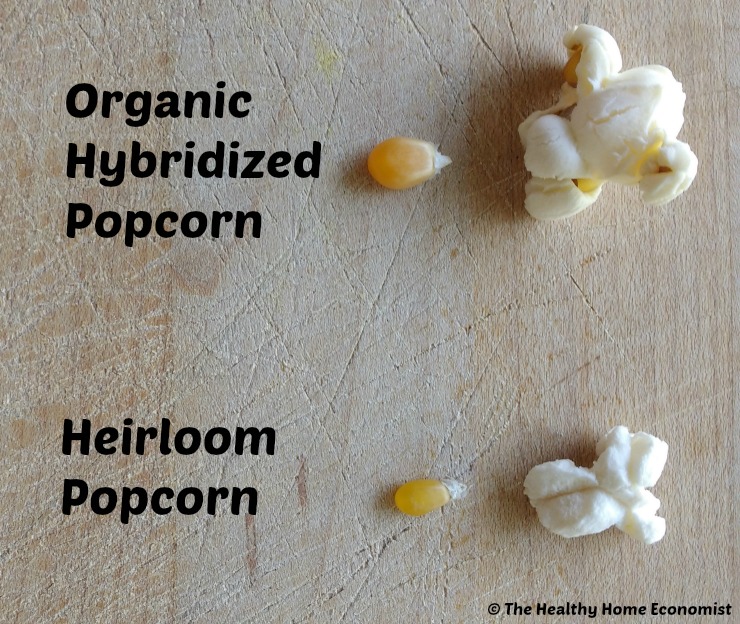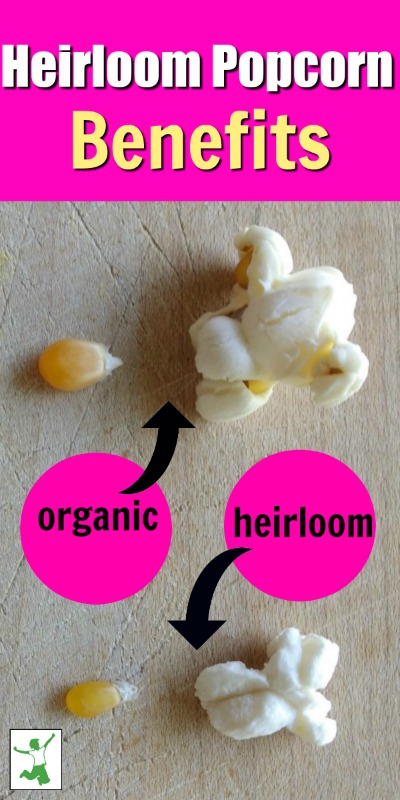Heirloom popcorn reinvents a modern snack with better flavor and nutrition with the added bonus of better digestibility and no hulls stuck in your teeth.

When it comes to making snacks for my family, popcorn cooked in healthy fat and sprinkled with sea salt is one of my all-time favorites.
Some folks like to add even more nutrition by sprinkling their bowl of popcorn with brewer’s yeast. This practice is a very tasty way to add lots of B vitamins. Be sure to get a quality source, though, as most are fortified with synthetic folic acid and B12.
You don’t even need any special equipment to make it. Who needs yet another kitchen appliance to find room to store anyway? A large frying pan with a (preferably) glass lid is all that is needed to make a large bowl of freshly popped kernels in just a few minutes. It’s so fast to make that I regularly pop a batch in the wee hours of the morning on schooldays even when I’m in a rush to pack my children’s lunchboxes (this video shows you how).
Daniel Patterson, head chef and owner of the famous restaurant Coi in San Francisco and author of Coi: Stories and Recipes, says that it is amazing “how many well-traveled, well-trained cooks have no idea how to pop popcorn!”
Heirloom Corn: Unchanged for Thousands of Years
Corn (maize) is a traditional food of the Native Americans who generously shared their knowledge and bounty with the early pioneers. Unfortunately, corn has changed drastically from what it was just a little over a century ago. And, these changes have not been for the better.
Hybridization of crops (selective cross-breeding) which became popular during the “Green Revolution” (talk about a misnomer!) in the mid-1900s to improve yields. This practice changed corn to a nearly unrecognizable form from a taste, flavor, and nutritional perspective.
Worse, genetic engineering of corn in the past couple of decades has added a dangerous element that consumers are wise to avoid. Note that genetic engineering differs significantly from hybridization.
GMO plants have actually had their DNA manipulated by adding one or more genes of completely unrelated plant species or even the genes of animals! Frankenfood indeed!
GMO corn cobs are now shockingly allowed to be sold as “fresh corn” in the produce section of supermarkets. It surely won’t be long until even conventional popcorn is GMO. It may be already, but who would know since it doesn’t have to be labeled?
(Most) Organic Popcorn is Hybridized (Heirloom Corn is Not)
While I’ve purchased organic corn kernels to make popcorn for many years, I didn’t realize until recently that even organic corn is hybridized!
Eating hybridized corn is not an unhealthy practice or dangerous like eating GMO corn. However, hybrid corn is less nutritious and flavorful.
When I realized that even organic popcorn is hybridized, I started searching for an heirloom popcorn alternative (suggested brand). What I found is very exciting!
Heirloom corn is so different from our modern concept of corn. The differences are really quite shocking. Key physical characteristics of heirloom corn include:
- Heirloom corn kernels are virtually hull-less and much smaller
- Heirloom corn grows on a bush with multiple stalks instead of a single stalk
- Each corn plant is only 3-5 feet high (compared with about 12 feet for conventional corn stalks)
- Each ear of corn is only 3 inches long
Notice in the picture above how much larger a kernel of hybridized (organic) corn is compared with an heirloom kernel! The resulting popcorn pieces are also much smaller.
Won’t Damage Your Teeth
While the physical differences between heirloom corn and hybridized corn are striking, the lack of a thick hull is most notable.
The very thin hull of each heirloom kernel allows it to virtually disintegrate when it is popped into popcorn. This makes it much easier to chew without those doggone hulls getting stuck in your teeth!
The lack of hulls also makes it a better option for those with braces, crowns, dentures, or tooth problems in general.
You’ve no doubt heard stories of people cracking a tooth eating regular popcorn. This type of thing won’t happen with heirloom!
Easier to Digest
Heirloom corn is not only easier to chew, but it is also easier to digest too. One big reason is the absence of hulls once the kernels are popped (they disintegrate). This characteristic makes it easier to pass through the digestive system as this insoluble fiber is missing.
My bet is that heirloom popcorn is also lower in phytic acid and other anti-nutrients, although I have not seen any definitive research on this to date. A lower level of anti-nutrients is important because popcorn is not soaked or sprouted before it is popped.
Perhaps the ease of digestion and potential lower level of anti-nutrients is why anecdotal evidence points to heirloom corn being well tolerated even by those with severe gut issues like ulcerative colitis, diverticulitis, or IBS where regular popcorn is contraindicated.

More Flavorful and Nutritious
Hybridized corn even when grown organically sacrifices flavor and nutrition for high yield.
In essence, hybrid forms of produce are lower in phytonutrients compared with wild, unmodified versions that have existed for thousands of years.
Studies published over the past 15 years confirm the startling fact. The high-yield farms of today have unwittingly bred the nutrition right out of our produce. (1)
Conveniently, a more nutritious corn kernel ultimately means a more tasty bowl of popcorn! So while your teeth and digestion will thank you for switching over to heirloom popcorn, your tastebuds will be singing too!
Good Brands to Try
My challenge to you is to try a bowl of heirloom popcorn for yourself.
I suggest this brand or this brand.
Better yet, see what your family thinks! Don’t tell them anything. Just serve a bowl of heirloom popcorn and listen for their response.
In my home, since trying out heirloom popcorn for the first time, my kids ask for nothing else!
Have you already tried it? If so, what was your reaction?








I’m curious whether you have an heirloom popcorn seed/company you can recommend to grow your own popcorn corn?
Not sure why you would recommend a food that is not organic, especially corn. I think I would prefer to eat my popcorn that has not been sprayed with pesticides, fungicides, and herbicides.
I’m wondering if you’ve tried organic sprouted popcorn (I’ve seen bags from To Your Health Sprouted Flour Co. and Thrive Market), and how it compares nutritionally to the heirloom popcorn you discuss in the article.
About 10 years ago I bean having allergic reactions to corn,HFCS,things that end in OSE (dextrose,glucose,fructose) it was a nightmare unless I was cooking at home. But I became (and still am) a big label reader.
I had a crazy idea that since I haven’t ALWAYS been allergic maybe it was because of all the changes they’ve made to corn. So, I tried the Tiny But Mighty popcorn.
I had NO REACTION, no itch, no rash, nothing! !
That’s the same brand of popcorn that I use. It’s delicious, I also use nutritional yeast on my popcorn, sea salt, and grass fed butter (Kerrygold). My dauhter and her friend always want more when I make popcorn.
I have looked for this type of yeast also and always see folic acid like this. I will be interested in what you find out, too!
This is off topic, but I am wondering which is the best source for accurate and complete information about raw milk, including any issues with it that are well documented. I find myself sometimes defending it against people who say it can kill you, and one person who says that his customer’s wife died from campylobacter from raw milk. I find various sources of information but none that is completely neutral.
The definitive guide to raw milk. If someone has gotten emotional about the issue and can’t be reasoned with, don’t bother. https://www.thehealthyhomeeconomist.com/raw-milk/
I love the Tiny but Mighty popcorn. I have one silly problem with it, though. Call me lazy, but imlove the convenience of an air popper, and this popcorn won’t pop in an air popper. The seeds are so small that they just fly right out. So, i still have almost a full bag of it in my pantry and tend to opt for the organic kernels for my air popper.
Hey Sarah, thanks for this article! My family and I are huge popcorn eaters, but have never heard of Heirloom so I just ordered it on Amazon from your link (Cant Wait!). Anyhow, we have used Black Jewell for years and love it. It too, has smaller kernels and it is certified Non-GMO, but we do have quite a few un-popped kernels left in the pan and get hulls stuck in our teeth, so I am looking forward to not having these issues. More importantly, I am looking forward to more nutrition and I, too, would assume (and hope) that there will be less phytic acid in Heirloom. Although we eat popcorn close to once a week, we would have it more often if I wasn’t so concerned with the phytic acid rotting our teeth. Thanks again. 🙂
Sarah, I was wondering if the Brewer’s Yeast would be safer than using the Nutritional Yeast with it’s fake folate (folic acid) added. We use to love eating the Nutritional yeast on popcorn until I found out about only eating folate and not folic acid. Thank you as always for all of your research!
Jennifer, this is an excellent question and thank you for bringing it to my attention! I just re-checked the label of the yeast I’ve linked to above and it does say “folic acid” on the label. However, I am pretty sure this is a mistake as no synthetic folic acid is added to this product. It is pure nutritional yeast, so I think the label is supposed to say “folate”. Perhaps the company decided to do this because most people don’t know the difference and look for folic acid even though “folate” is really what they want? I am not sure. But, I will check with the company to find out! In the meantime, I feel quite confident in this product I’ve linked to. I’ve used it for many years without a problem and it is recommended for addition to the homemade baby formula too because it is so much better (low temp processed so low to no MSG formed) than the brands of brewer’s yeast that are out there that I’ve investigated.